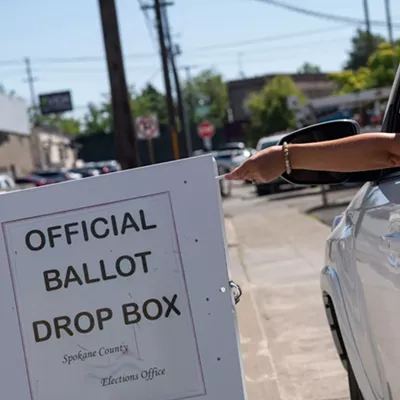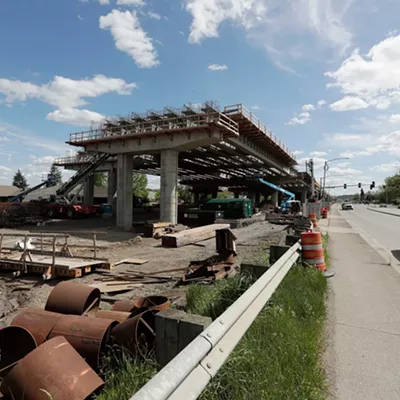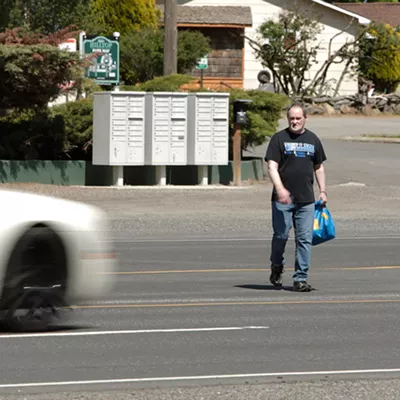One of my jobs," says New York Times best-selling author Ridley Pearson, "is to make you forget what time it is. This is, after all, escapist fiction. It's something to take you away." It's a job that Pearson has been doing now for 14 books. And in his most recent, Parallel Lies, he has chosen a fittingly transitory setting -- the approximately 33,000 miles of train track that web across America.
Pearson will be reading from Parallel Lies tonight at Auntie's. In the book, a former homicide cop is hired to investigate a murder that happened in a boxcar belonging to the Northern Union Railroad. As the mystery unravels, a suspect emerges who has targeted the railroad company for multiple freight-train derailments. Like the trains in the story, the novel accelerates to an unstoppable pace, which is typical of a suspense author that Publishers Weekly has called "better than anybody else in the business."
One of the inspirations to use trains as the literal and literary vehicle for the book came to Pearson like most of his ideas -- from actual news stories that he constantly combs newspapers to find. "About five or six years ago, there was a case when nine people were killed along the railroad tracks in the Midwest. And the federal government launched this giant manhunt; and they knew that they had a homeless man somewhere on those 33,000 miles of track that was killing people. And they caught him. And just the fact that they caught him amazed me."
The second part of the story came together for Pearson when humor columnist Dave Barry, who plays in a band with Pearson, informed him that approximately 1,000 people each year were killed on or along railroad tracks. "Children, suicides, homeless guys, maintenance workers, you know, it's nearly three a day. And that led me to do some research into that. It turns out that number doesn't include fatalities in vehicular accidents that are struck by trains. And that that number has grown so large that the government now doesn't investigate a vehicular accident with a train unless five or more people are killed. And that kind of stood my hair on end.
"And then another piece of the puzzle for me was that I read that Amtrak was testing a bullet train between New York and Washington, D.C. And when I heard they were doing that, as a novelist, I said, 'There's my final act.' That's the third act of this dramatic structure -- that test run of a bullet train."
Along with his believable plots and tightly wound pacing, however, for fans of Pearson's books, one of the strongest driving forces is the characters he creates, and the legitimacy that he brings to his villains.
"You know, it's not my favorite thing to write psycho-killers as the villains in my novels," Pearson chuckles. "So I try to write as believable a person as I can. Someone committing crimes for his or her wrong idea, but an idea that we can at least vaguely understand, although not support, and thereby make these people more human than just nuts. And with the accident/fatalities along railroad tracks, I thought I had a pretty good revenge novel. That if somebody had been slighted by a railroad company and had lost his entire family to a car accident on the track, that it's not inconceivable a few years down the road of trying legal maneuvering to get the blame in the right place. Because he clearly blames the railroad, and they clearly blame his wife for sticking herself out on the track -- he finally turns to hurting the company the only way he knows how. Which is to hurt their bottom line, and he starts rolling freight cars."
Of course, every antagonist needs a protagonist, and in Pearson's novels that role often falls to Seattle cop Lou Boldt, who has been featured in half of Pearson's books. For Parallel Lies, however, Pearson created a new lead character: Peter Tyler, a cop who lost his badge after beating a child abuse suspect and who finds his own past targeted as the story unfolds.
"Sometimes you start books with characters, and sometimes you start books with ideas," Pearson explains. "I really believe that setting must be a character, or should be a character in a novel. And that it's important to use that setting correctly. With something as broad-ranging and far-reaching as train travel, it would have been a real push to involve Boldt and any of his cast in this in any way that wouldn't seem forced and heavy handed. And at the time that I was doing all of this train research, I had kind of stumbled on this -- I suppose not terribly creative -- idea of a guy who's been beaten up himself. So that our protagonist is in some ways in the same situation as our antagonist.
"And like parallel tracks," Pearson continues, "these two lives are going to grow closer and closer in perspective. And at some point, the cop's going to find himself chased, and feel exactly like the guy that he's chasing. And they would almost swap lives in some ways. I'm trying to move you all over the map on this, and not just make it white hats and black hats."
Ridley Pearson reads from Parallel Lies at
7:30 pm, Thursday, July 26, at Auntie's Bookstore. Call: 838-0206.
















